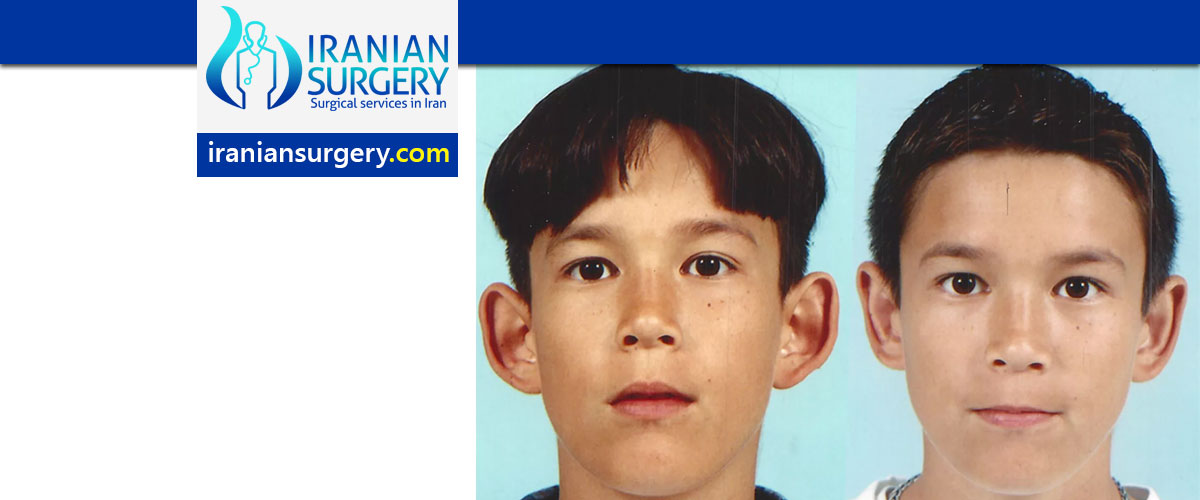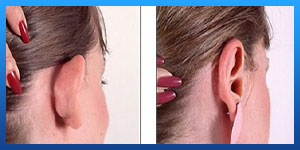Otoplasty in Iran

Otoplasty (Cosmetic Ear Surgery) in Iran
Otoplasty Cost
The cost of Otoplasty in Iran varies depending on the type of cosmetic ear surgery, geographical location and surgeon's fee.
The cost of Otoplasty in Iran is between $ 1000-2500.

General information about Otoplasty (Cosmetic Ear Surgery) in Iran
The following table describes general information about Otoplasty in Iran including Otoplasty cost in Iran, recovery time, and to name but a few.
General Information |
|
Cost | $ 1000- 2500 |
Anesthesia | General / Local |
Hospital Stay | The Same Day |
Back to Work | 1 Week |
Duration of Operation | 1-3 hours |
Minimum Stay in Iran | 1 Week |
About Iranian Surgery
Iranian surgery is an online medical tourism platform where you can find the best cosmetic Surgeons in Iran. All cosmetic surgeons working with Iranian Surgery specialize in plastic surgery and perform cosmetic surgeries in well-equipped hospitals/clinics, so after Otoplasty (Cosmetic Ear Surgery) in Iran you will face the least possible complications.
For more information about the cost of Otoplasty (Cosmetic Ear Surgery) in Iran and to schedule an appointment in advance, you can contact Iranian Surgery consultants via WhatsApp number 0098 901 929 0946. This service is completely free.

Read more about : Rhinoplasty podcast with Dr Afshan shah
Read more Read : Rhinoplasty surgery , Before and after surgery Videos
Read more about : Belepharoplasty surgery , Before and after surgery Videos
Read more about : Belepharoplasty surgery , Before and after surgery Videos
Read more about : Lipomatic surgery , before and after surgery Video
Read more about : Abdominoplasty and Breast reduction and bbl surgery , before and after surgery videos
All you should know about Otoplasty Procedure
What is Otoplasty?
Otoplasty also known as cosmetic ear surgery is a procedure to change the shape, position or size of the ears.
You might choose to have otoplasty if you're bothered by how far your ears stick out from your head. You might also consider otoplasty if your ear or ears are misshapen due to an injury or birth defect.
Otoplasty can be done at any age after the ears have reached their full size — usually after age 5 — through adulthood. In some cases, the surgery is done as early as age 3.
If a child is born with prominent ears and certain other ear-shape problems, splinting may successfully correct these issues if started immediately after birth.
The outcome of cosmetic ear surgery varies greatly depending on the changes that are desired, but these procedures generally improve self-confidence, especially in children and teenagers.
Read more about Cochlear Implants in iran
Before Otoplasty (Cosmetic Ear Surgery)
When to consider Otoplasty (Cosmetic Ear Surgery)
. If you were born with overly large or small ears
. If your ears are disproportionate to your head or oddly placed
. If your ears protrude or stick out prominently
. If you have suffered an injury that has negatively impacted the shape or positioning of your ears.
. If your self-esteem or self-image would improve from such a procedure
Otoplasty won't change the location of your ears or alter your ability to hear.
Advantages and Disadvantages
Pros:
. Otoplasty can improve the shape and proportion of your ears.
. Otoplasty can provide a boost to your self-confidence and is a low-risk procedure that can be performed on children over the age of five.
. Results generally last a lifetime with minimal fluctuations.
Cons:
. Young children might have trouble dealing with aftercare and recovery.
. Ear symmetry may be affected.
. Permanent scarring or numbness of the ear or face may result.
These are the top three pros and cons to weigh when considering ear surgery. If you want to focus on what is unique to you, please consult with your aesthetic plastic surgeon.
Are you a good candidate for Otoplasty (Cosmetic Ear Surgery)?
The following are some common reasons why you may want to consider Otoplasty:
. If your ears have reached their full size, which usually happens around age six. Children are common patients for this procedure.
. A set-back otoplasty, which is a procedure to reduce the prominence of ears that stick out too much, can be performed on adults as well as children.
If you are in good general health, have a positive attitude and realistic expectations, you are most likely a good candidate for otoplasty.
Risks and Complications
There are few risks associated with Otoplasty (Cosmetic Ear Surgery), but as with any invasive surgery, there’s always a potential for complications. It’s important to be in regular contact with your surgeon after your procedure to ensure you are on the right track to recovery.
Some of the potential complications of all surgeries are:
. Adverse reaction to anesthesia
. Hematoma or seroma (an accumulation of blood or fluid under the skin that may require removal).
. Infection and bleeding
. Changes in sensation
. Scarring
. Allergic reactions
. Damage to underlying structures
. Unsatisfactory results that may necessitate additional procedures
Following your procedure, it’s normal for your ears to swell and feel tender. You may also see redness around the affected area and experience tingling in the outer ear, though this will reduce over time.
If you notice any of the following issues during your otoplasty recovery, it’s essential that you contact your surgeon immediately:
. Swelling or redness that lasts for longer than two weeks
. A fever higher than 101 degrees
. Dizziness, nausea, or incoherent behavior such as hallucinations
. Severe pain that cannot be controlled with any prescribed pain medication
. Excessive bleeding in or around your ears
. Any severe disproportion in your ears, particularly if it looks as though fluid is collecting in one ear.
The rare but potential risks associated with ear surgery are:
. Scarring, though most scars will be small, white, and unnoticeable
. Alterations in the sensitivity of the skin on or around your ears
. Bleeding or infection
. Asymmetry in the positioning of your ears due to changes that occur post-operatively.
. Problems with stitches. Stitches used to secure the ear's new shape might work their way to the surface of the skin and need to be removed. This can cause inflammation of the affected skin. As a result, you might need additional surgery.
If you notice any of these issues, get in touch with your surgeon as soon as possible to discuss plans for further treatment.
You can help minimize certain risks by following the advice and instructions of your board-certified plastic surgeon, both before and after your ear surgery.
Preparing for Your Procedure
How do I prepare for an Otoplasty (Cosmetic Ear Surgery)?
Your surgeon will provide thorough pre-operative instructions, answer any questions you may have, take a detailed medical history, and perform a physical exam to determine your fitness for surgery. If your doctor asks you to undergo any pre-surgery testing, be sure to schedule well in advance of your procedure.
In advance of your procedure, your surgeon will ask you to:
. Stop smoking at least six weeks before your surgery to promote better healing.
. Avoid taking aspirin, certain anti-inflammatory drugs, and some herbal medications that can cause increased bleeding.
. Regardless of the type of surgery to be performed, hydration is very important before and after surgery for safe recovery.
. Practice good skincare. You should rinse the skin on and around your ears with warm water and use sunscreen.
Eating well, minimizing stress, and exercising frequently are important to make sure you are best prepared for your surgery. You should also plan ahead for the recovery period after your procedure by taking time off from work and ensuring that you have everything you’ll need close at hand while recovering.
During Otoplasty (Cosmetic Ear Surgery)
What can I expect on the day of ear surgery?
On the day of your otoplasty procedure, you’ll be asked not to take anything by mouth, including any food. You should only drink the minimal amount of water needed to brush your teeth and rinse your mouth—anything more than this could result in the cancellation of your surgery. Wear comfortable clothing on the day of your procedure.
Your ear surgery may be performed in an accredited hospital/clinic, free-standing ambulatory facility, or office-based surgical suite.
. Medications are administered for your comfort during the surgical procedure.
. General anesthesia is commonly during your ear procedure, although local anesthesia or intravenous sedation may be desirable in some instances.
. For your safety during the surgery, various monitors will be used to check your heart, blood pressure, pulse, and the amount of oxygen circulating in your blood.
. Your surgeon will follow the surgical plan discussed with you before surgery.
. After your procedure is completed, you will be taken into a recovery area where you will continue to be closely monitored.
You will probably be permitted to go home after a short observation period unless you and your plastic surgeon have made other plans for your immediate post-operative recovery.
How is an Otoplasty (Cosmetic Ear Surgery) performed?
In children, the ear cartilage is soft enough that splints can be used for contouring during surgery. This is typically done under general anesthesia. Adults, however, have harder cartilage, and the procedure must be carried out by removing or repositioning cartilage after making a small incision in the ear.
Depending on your anatomy and desired changes, your doctor may make an incision hidden inside or behind the ear. Excess cartilage or soft tissue that makes the ear protrude too much can be removed. If normal folds are missing from the ear, they can be re-created by shaping the cartilage with permanent sutures or scraping the cartilage to contour it. Sometimes a combination of techniques is needed to get the desired result.
The procedure can take between 1 to 3 hours, depending on the specifics and complexity of the procedure.
Types of Otoplasty (Cosmetic Ear Surgery)
. Ear augmentation. Some people may have small ears or ears that haven’t completely developed. In these cases, they may want to have otoplasty to increase the size of their outer ear.
. Ear pinning. This type of otoplasty involves drawing the ears closer to the head. It’s performed on individuals whose ears stick out prominently from the sides of their head.
. Ear reduction. Macrotia is when your ears are larger than normal. People with macrotia may choose to have otoplasty to reduce the size of their ears.
What will my ear surgery incisions and scars be like?
The location of your incisions will depend largely on what changes you wish to make. However, you can expect the incisions to be made in inconspicuous locations, either in the back of your ear where it connects to the head, or within the inner folds of your ear.
After Otoplasty (Cosmetic Ear Surgery)
Aftercare and Recovery
Your surgeon will discuss how long it will be before you can return to your normal level of activity and work. After surgery, you and your caregiver will receive detailed instructions about your post-surgical care, including information about:
. Drains, if they have been placed
. Normal symptoms you will experience
. Potential signs of complication
It is vitally important that you follow all patient care instructions provided by your surgeon, and to realize that the amount of time it takes for recovery varies greatly among individuals.
Immediately after surgery
Following the procedure, you will have dressing wrapped around your ears. Soon after the procedure, your doctor will remove this heavier bandage to inspect the ears, and will likely replace it with a lighter dressing. It’s essential to keep this dressing in place unless instructed to do otherwise by your doctor. Your surgeon may also prescribe medication to take during your recovery period.
Typically, you will be released from the hospital or ambulatory facility the same day as your procedure, but you must have someone drive you to and from the surgery.
Recovery time frame after ear surgery
You should have a responsible adult with you for at least the first twenty-four hours during your recovery period. For the first week of recovery, it’s important that you rest frequently, though you should still move around occasionally to keep blood flowing. To minimize discomfort, it’s recommended that you recline but keep your head elevated. Do not rest your head on the operated ear, as this can result in throbbing and general discomfort.
Your doctor will let you know when any dressing can be removed, and you may be asked to apply antibiotic ointment to the ears or perform other wound care treatment at home.
Approximately one week after your procedure, you will return to the doctor’s office. Your surgeon may remove stitches at this time, though absorbable stitches are often used, which do not require removal.
Though recovery is unique for every patient, you can expect to return to work and any light activity after one week. In two weeks, your final results will be visible, though small changes to the ears can occur for up to twelve months.
How long will the results last?
Results from otoplasty are typically life-long, barring any incidents which impact the shape or proportion of the ears.
Maintain a relationship with your aesthetic plastic surgeon
For safety, as well as the most beautiful and healthy outcome, it’s important to return to your plastic surgeon's office for follow-up evaluation at prescribed times and whenever you notice any changes in your ears. Do not hesitate to contact your surgeon when you have any questions or concerns.
Otoplasty Surgeons
How can I find the best Otoplasty surgeon in Iran?
Otoplasty surgeons in Iran can make your face more appealing. Otoplasty surgeons in Iran can also help you in making your final decision about what type of Otoplasty is more suitable for you.
It is important that you seek the assistance of experienced and skilled Otoplasty surgeons in Iran who have provided a suitable condition for people with limited budgets to undergo Otoplasty in Iran easily. It is worth explaining that the quality provided by Iranian surgeons is far higher than other countries including Turkey and India.
Plastic surgeons in Iran, have performed numerous procedures annually which make them more experienced than other countries’ plastic surgeons, due to high demand and low cost of Otoplasty in Iran, thousands of people travel to Iran every year to undergo Otoplasty in Iran with the best Otoplasty surgeons at an affordable and reasonable price.
Plastic surgery hospitals in Iran
Tehran hospitals
- Moheb Kosar Hospital
- Imam Khomeini Hospital
- Ebnesina Hospital
- Parsian Hospital
- Pasteurno Hospital
- Kasra Hospital
- Treata Hospital
Shiraz hospitals
- Mirhoseini Hospital
- Ordibehesht Hospital
- Mir Hospital
- MRI hospital
- Dena Hospital
- Abualisina Hospital
- Ghadir Mother and Child Hospital
Mashhad hospitals
- Imam Reza Hospital
- Mehregan Hospital
- Hashemi Nezhad Hospital
- Farabi Hospital
- Mehr Hospital
- Sina Hospital
- Bentolhoda Hospital

